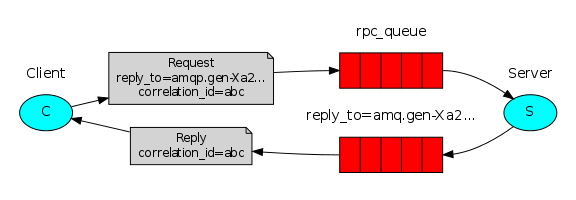远程调用
RPC模式
生产者发送消息给Exchange, Exchange把消息推送给消费者,消费者接收,处理完消息,返回响应给生产者
客户端接口
生产者创建一个FibonacciRpcClient的客户端,call方法会发送消息给rabbitMQ,阻塞当前程序直到收到响应为止
fibonacci_rpc = FibonacciRpcClient() result = fibonacci_rpc.call(4) print("fib(4) is %r" % result)
回调队列
生产者在发送消息前会创建一个回调队列,用来接收消费者发回的响应,在发送消息的时候用reply_to属性标记回调队列,而当消费者处理完消息后把结果包装到响应内再发送给回调队列
result = channel.queue_declare(exclusive=True) callback_queue = result.method.queue channel.basic_publish(exchange='', routing_key='rpc_queue', properties=pika.BasicProperties( reply_to = callback_queue, ), body=request)
correlation id
同一个rpc客户端接口可能发送多次请求,而通过同一个回调队列也相应会接收到多次返回响应,为了标明哪个响应对应哪个请求,所以在发送请求的时候会带上一个id, 这个id就用correlation_id来标识
result = channel.queue_declare(exclusive=True) callback_queue = result.method.queue corr_id = 123456789 channel.basic_publish(exchange='', routing_key='rpc_queue', properties=pika.BasicProperties( reply_to = callback_queue, correlation_id = corr_id, ), body=request)
综合实例

生产者
#!/usr/bin/env python import pika import uuid class FibonacciRpcClient(object): def __init__(self): self.connection = pika.BlockingConnection(pika.ConnectionParameters( host='localhost')) self.channel = self.connection.channel() result = self.channel.queue_declare(exclusive=True) self.callback_queue = result.method.queue self.channel.basic_consume(self.on_response, no_ack=True, queue=self.callback_queue) def on_response(self, ch, method, props, body): if self.corr_id == props.correlation_id: self.response = body def call(self, n): self.response = None self.corr_id = str(uuid.uuid4()) self.channel.basic_publish(exchange='', routing_key='rpc_queue', properties=pika.BasicProperties( reply_to = self.callback_queue, correlation_id = self.corr_id, ), body=str(n)) while self.response is None: self.connection.process_data_events() return int(self.response) fibonacci_rpc = FibonacciRpcClient() print(" [x] Requesting fib(30)") response = fibonacci_rpc.call(30) print(" [.] Got %r" % response)
- 建立与rabbitMQ服务器的connect, channel, 以及声明一个回调队列callback_queue
- self.channel.basic_consume:注册callback队列,监听响应
- 'on_response':检查响应中的correlation_id是否和发送的一致,如果一致把响应的body保存下来
- call:产生唯一的correletion_id, 发送消息给rabbitMQ服务器,盲等待响应到了,返回最后结果
消费者
#!/usr/bin/env python import pika connection = pika.BlockingConnection(pika.ConnectionParameters( host='localhost')) channel = connection.channel() channel.queue_declare(queue='rpc_queue') def fib(n): if n == 0: return 0 elif n == 1: return 1 else: return fib(n-1) + fib(n-2) def on_request(ch, method, props, body): n = int(body) print(" [.] fib(%s)" % n) response = fib(n) ch.basic_publish(exchange='', routing_key=props.reply_to, properties=pika.BasicProperties(correlation_id = \ props.correlation_id), body=str(response)) ch.basic_ack(delivery_tag = method.delivery_tag) channel.basic_qos(prefetch_count=1) channel.basic_consume(on_request, queue='rpc_queue') print(" [x] Awaiting RPC requests") channel.start_consuming()
消费者接受消息,解析计算参数,计算结果,包装响应,发送消息给回调队列。注意:routing_key=props.rely_to, correlation_id = props.correlation_id
测试
启动消费者
$ python rpc_server.py [x] Awaiting RPC requests
发送rpc请求,等待计算结果
$ python rpc_client.py [x] Requesting fib(30)